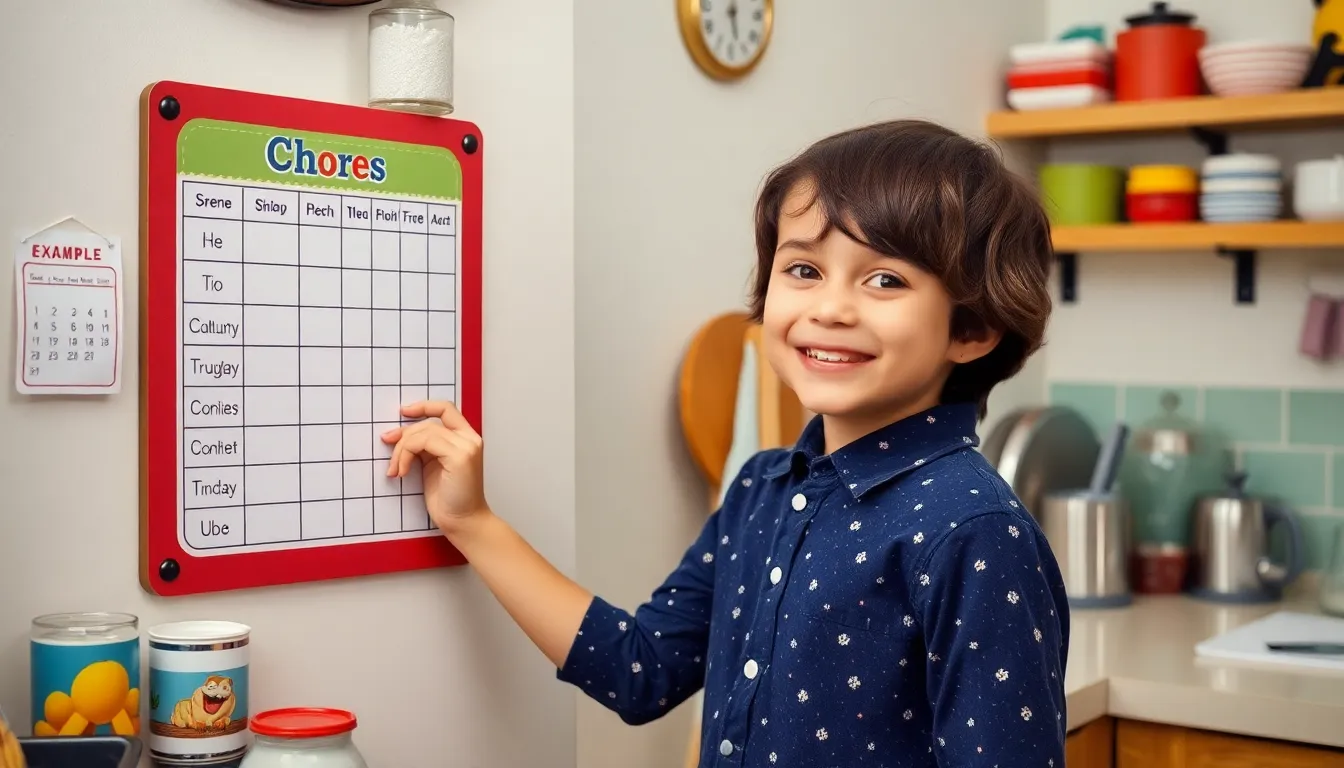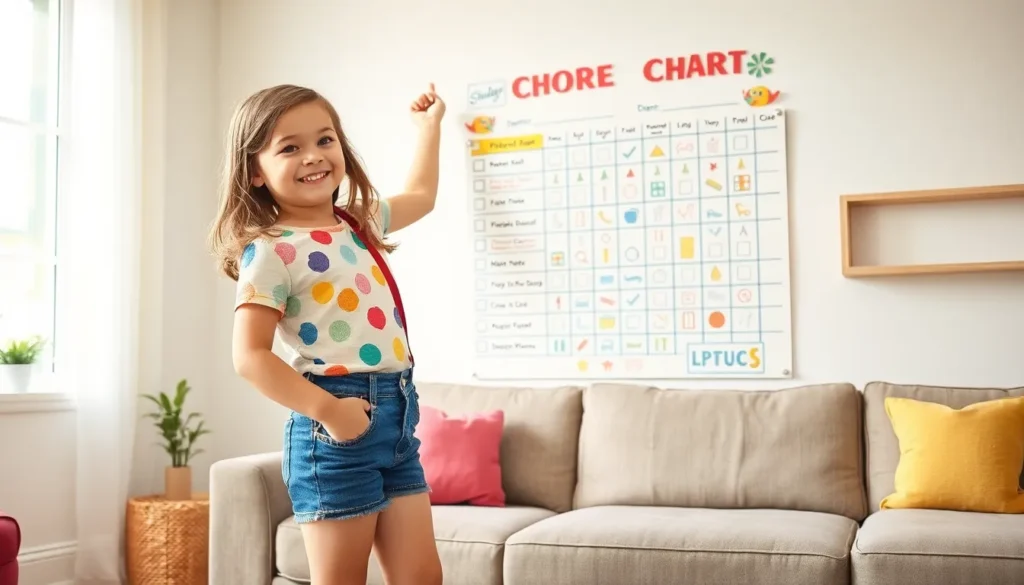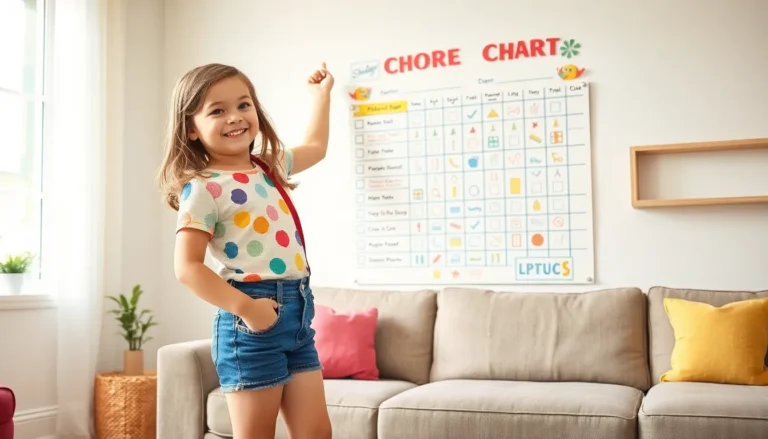Table of Contents
ToggleEvery parent knows the struggle: getting kids to help around the house can feel like herding cats. Enter the kids chore chart, a magical tool that transforms reluctant little helpers into enthusiastic taskmasters. With a colorful chart hanging on the wall, kids can track their chores and earn rewards, all while avoiding the dreaded “I’m bored” declaration.
Imagine a world where your children actually fight over who gets to vacuum or take out the trash. Sounds like a dream, right? But with the right chore chart, that dream can become a reality. Not only does it teach responsibility, but it also turns chores into a fun game, making family life a little less chaotic and a lot more entertaining. So let’s dive into the world of chore charts and discover how they can bring harmony to your household.
Overview of Kids Chore Charts
Kids chore charts serve as effective tools for encouraging children to participate in household tasks. These colorful charts can capture a child’s interest and transform chores into engaging activities. With the right design, chore charts motivate kids to take ownership of their responsibilities.
Using a chore chart also instills a sense of achievement as children complete tasks. Daily and weekly tasks appear clearly laid out, making it easier for kids to understand expectations. Children often enjoy checking off completed chores, reinforcing positive habits.
Many families choose to tailor chore charts based on age and skill level. For instance, younger children may handle simpler tasks like putting away toys, while older children might take on more complex responsibilities like washing dishes. This flexibility allows parents to adapt chore assignments to suit their child’s developmental stage.
Rewards can enhance the effectiveness of this tool. Parents might implement a points system where children earn rewards for completing chores regularly. Rewards could range from screen time to special activities, aligning incentives with family values.
Creating these charts involves simple materials, making them accessible for most families. Parents can craft customizable charts using colorful paper or digital platforms available online. Engaging children in the design process often increases their investment in its success.
Overall, implementing chore charts promotes accountability and teamwork within the family unit. Children learn valuable life skills while contributing to their household, fostering a more supportive family environment.
Benefits of Using Kids Chore Charts

Using kids chore charts brings multiple advantages that support children’s growth and family dynamics. These charts create a structured approach to responsibilities, making the process enjoyable and interactive.
Encouraging Responsibility
Kids chore charts encourage children to take on their responsibilities actively. When kids see their tasks listed, they learn to prioritize and manage their time. Completing assigned tasks fosters a sense of accountability. As children check off chores, they experience accomplishment, reinforcing their commitment. This consistency in effort leads to the development of dependable habits over time. Engaging with chore charts helps kids understand the relationship between effort and reward, boosting their sense of ownership in family dynamics.
Building Life Skills
Chore charts effectively build essential life skills among children. Skills such as time management and organization become natural as kids participate in daily tasks. Completing chores fosters teamwork and communication, crucial for future collaborative environments. Children also gain problem-solving abilities by navigating challenges related to their responsibilities. Through this process, kids develop resilience, learning to adapt when faced with setbacks. Life skills encourage independence, preparing children for future challenges in various settings, including school and social interactions. These benefits establish a foundation for lifelong success.
Types of Kids Chore Charts
Chore charts come in various formats to meet family needs. Parents can choose between printable versions and digital applications to motivate children effectively.
Printable Chore Charts
Printable chore charts serve as tangible tools for families. These charts can be easily downloaded and customized to fit children’s ages and responsibilities. Bright colors and fun designs capture attention, making chores seem appealing. Parents often find it helpful to include visual elements, such as stickers or illustrations, to encourage younger children. Completing tasks leads to checking off chores, providing a sense of accomplishment. Customization options help parents tailor chores based on individual skill levels, making the process more engaging.
Digital Chore Chart Apps
Digital chore chart apps provide convenience and flexibility. These applications allow parents to manage chores on smartphones or tablets, making accessibility easy. Many apps offer built-in reward systems, creating an additional incentive for children to complete their tasks. Notifications remind kids of their responsibilities, enhancing accountability. Customizing tasks with specific deadlines helps children develop time management skills. Many digital platforms include gamification elements, further motivating children to engage actively in their household duties. Overall, these apps support interactive learning while keeping families organized.
Tips for Implementing Kids Chore Charts
Implementing a kids chore chart effectively boosts engagement and accountability. Two crucial elements in this process are involving kids and setting realistic goals.
Involving Kids in the Process
Involvement significantly increases ownership and enthusiasm. Parents can start by discussing the chore chart with their children. Getting input on the tasks helps tailor responsibilities to interests. Children may enjoy choosing colorful designs or sticker rewards. Encouraging kids to suggest chores fosters a sense of control. Including them in creating the chart makes it feel less like a parental directive. Engaging with the chart regularly offers valuable opportunities for discussion and adjustments. It’s essential to celebrate accomplishments together, reinforcing their efforts.
Setting Realistic Goals
Setting achievable goals promotes confidence and commitment. Parents should assess age and abilities when assigning tasks. Younger children benefit from simpler chores, like putting away toys. Older kids can take on responsibilities, like doing laundry or meal prep. Break down larger chores into smaller steps, making them less overwhelming. Clarity in expectations helps children understand what success looks like. Regularly reviewing and adjusting goals ensures they remain applicable over time. Celebrating progress along the way bolsters motivation and teamwork.
Kids chore charts offer an effective way to engage children in household responsibilities while fostering essential life skills. By transforming chores into a fun and interactive experience, these charts not only motivate kids but also promote accountability and teamwork within the family. Tailoring the charts to fit children’s ages and abilities ensures that tasks are manageable and rewarding.
Involving children in the creation process enhances their investment in the system, making them more likely to participate enthusiastically. As kids check off completed chores and celebrate their achievements, they develop a sense of responsibility that extends beyond the home. With the right approach and tools, families can create a positive environment that encourages cooperation and growth for everyone involved.






